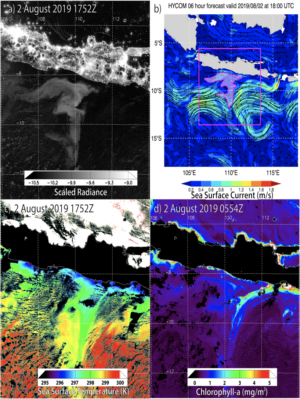Featured image: Processed satellite images showing a milky sea event and its components in Java, 2019. From Miller et al, 2021 (figure 5).
Sailors see a lot of, well, stuff while they’re far from land. And they’re known for telling unbelievable tales, some of which later turn out to be more or less true. Milky seas are one of those: a horizon-to-horizon sea that glows white like the snow in the moonlight. In a 2021 paper, Dr. Steven Miller of Colorado State University and colleagues used satellites to look for these systems in hopes of understanding how and why these glowing patches form.
The first satellite detection of a milky sea event was also the work of Dr. Miller, in a 2005 paper that detected just a single event by combing ships’ logs and satellite archives from the preceding decade. Now, Miller’s research team has refined the algorithm that he’d previously developed for modern satellite records. Today’s satellite technology is better able to ‘see’ these events due to higher resolution of their images and can pick out the bioluminescent glow of microbes in the ocean better than the last generation of satellites.
By applying their algorithm to satellite data recorded from 2012-2021, the team detected 12 milky sea events in the Indian Ocean and far western Pacific (near Indonesia and Malaysia). Surprisingly, milky seas grew larger and lasted longer than they’d originally expected — one event covered an area the size of Iceland, and another event appeared to last a whole month.
The researchers’ findings support their hypothesis that milky sea events are driven by increases of nutrients in the ocean, which drive large phytoplankton blooms. And then glowing microbes consume these photosynthesizers. In order for their milky glow to be visible to the naked eye or satellites, there needs to be a high density of microbes., And according to the authors’ calculations, the nutrients and phytoplankton population required for milky seas are staggeringly huge: on the order of a trillion trillion individuals (that’s a ten with 24 zeros after it) supporting about a billion trillion luminescent bacteria (a ten with 21 zeros after it).
Based on their results, Miller and his colleagues gave detailed descriptions of previous milky seas events. But they say that their detection algorithm could lead to detecting milky seas in real-time, allowing research ships to be diverted towards them. So far, only one event, in 1985, has ever been sampled by a research vessel And in that case, it was purely by chance. Modern technology, such as environmental DNA or eDNA sequencing of seawater and microbe samples, could reveal how these seemingly magical events come to pass — just as the advances in satellite and computing technology have already confirmed that they aren’t a myth after all.

